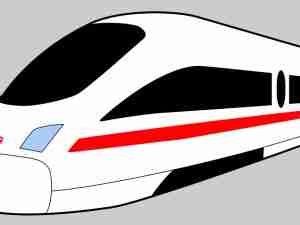BNSF Railway has completed construction of a third main rail line through Cajon Pass in Southern California that will increase capacity on BNSF's Chicago to Los Angeles Transcontinental (Transcon) route from 100 to 150 trains a day. The $90 million project adds almost 16 miles of third main track to BNSF's route into the Los Angeles Basin.
Cajon Pass is located between the San Gabriel and San Bernardino mountain ranges, just north of the City of San Bernardino. Approximately 75 to 100 freight and passenger trains currently traverse this route on a daily basis. Each intermodal train on these tracks can take more than 250 long-haul trucks off of the region's local highways. Additionally, freight trains are more fuel-efficient than trucks and can move one ton of freight more than 400 miles on one gallon of diesel fuel.
"Cajon Pass is our only Southern California connection to the rest of the BNSF network from the San Pedro Ports," said Mark Kirschinger, BNSF general manager, California Division. "Maintaining efficient train movements through Cajon Pass is critical to supporting the growth and vitality of local, regional and the national economies."
Throughout the development process, BNSF worked closely with at least 17 public agencies, six utility companies, and the community on issues ranging from enhancement and protection of the environment, to improved grade crossings, drainage structures, as well as preservation of historical and cultural resources.
Over the last four years, more than 300 BNSF employees and contractors worked on the Cajon Pass project. In that time, crews moved more than 1 million tons of earth, placed approximately 42,000 concrete railroad ties, and laid more than 30 miles of steel rail. The construction of this track represents the first additional BNSF main track through Cajon Pass since the second line was constructed in 1913, nearly 100 years ago.
TOP ENVIRONMENTAL AWARD
Lyle W. Staley, manager, BNSF Environmental Program Development, Topeka, Kansas, was awarded the Association of American Railroads 2008 North American Environmental Employee Excellence Award at the 2008 Railroad Environmental Conference.
"Staley has dedicated himself to advancing BNSF's environmental initiatives in new and innovative ways," said Mark Schulze, BNSF vice president, Safety, Training and Operations Support. "His work in fuel conservation and spill prevention has resulted in not only successful programs that help in protecting the environment. Many of the programs under his leadership were originally developed for just one BNSF facility, but have now been implemented elsewhere on BNSF's network."
A 39-year railroad veteran, Staley was instrumental in leading BNSF's certification for the American Chemistry Council's Responsible Care Management System (RCMS), a health, safety, security and environmental continuous improvement process that applies an integrated, structured approach to drive results key areas. Staley also developed a database for estimating locomotive emissions that is used in meeting government requirements.
"Railroads are the greenest of the surface transportation modes," said Association of American Railroads President and CEO Edward R. Hamberger. "Partly it is because of the inherent efficiency of the steel wheel on steel rail, which last year allowed railroads to move each ton of freight an average of 436 miles per gallon of diesel fuel.
"But even more importantly, our industry has countless dedicated employees like Lyle Staley who are passionate about protecting and enhancing the environment. They are our industry's ultimate environmental advantage."
BNSF RECOGNIZED BY HONDA
BNSF Railway Company was recognized by American Honda Motors for outstanding teamwork in Honda's Western Region at Honda's Annual Supplier Conference in San Diego, Calif. BNSF received this award for its ability to provide superior quality transportation and damage-free delivery in conjunction with Pacific Motor Trucking






